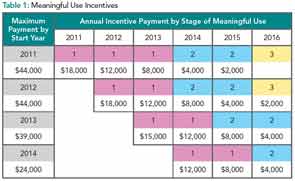The Centers for Medicare and Medicaid Services (CMS) recently published the final rule for the next stage of the Meaningful Use Incentive Program. Stage 1 focused on data capturing and sharing. Stage 2, which has been delayed until 2014, will focus on using data collected for more advanced clinical processes.
Stage 1 Revisited
As authorized by the 2009 American Recovery and Reinvestment Act, CMS is providing reimbursement incentives to providers who can demonstrate ‘meaningful use’ of electronic health record (EHR) systems. Like their colleagues throughout medicine, many rheumatology providers were practicing in settings that use paper medical records. Through the CMS EHR Incentive Program, the government is incentivizing providers and hospitals to:
- Adopt EHRs;
- Implement the systems locally in ways that fully realize the potential of electronic systems; and
- Use the EHRs to exchange data.
The program is one component of the broader Health Information Technology for Economic and Clinical Health Act (HITECH) and raises the potential for greater efficiency, improved quality, and effectively coordinated care. HITECH’s reach includes the development of a framework and infrastructure to support health information technology adoption and implementation, health information exchange infrastructure, HIT workforce training, and health information and communication systems research and development.
A timeline for incentives based on the year you begin attestation is outlined in Table 1
The Stage 2 Rule Has Been Released—How It Affects You
The basic framework for meaningful use includes requirements to meet all core measures in addition to selecting from a number of menu measures, as well as to report on clinical quality measures. In Stage 1, providers reported on 15 core measures and five of 10 menu measures. In Stage 2, providers will need to report on 17 core objectives and select three of six menu set objectives. However, there are increasing thresholds and requirements in Stage 2, and many of the measures now have multiple parts.
Changes in Action
Stage 2 of meaningful use raises the bar on many of the requirements of Stage 1, in addition to introducing some new focus areas. For example, there is a stronger emphasis on the use of electronic messaging in order to communicate with patients about relevant health information. In addition, patients will need to have the ability to view, download, and transmit their health information to their provider with at least 5% of all unique patients actually accessing their information. Also, there will be a focus on summary-of-care records being made available for transitions of care and referrals. Another major area will be implementing clinical decision support interventions on high-priority health conditions, which will also tie in with the updated clinical quality measures.
